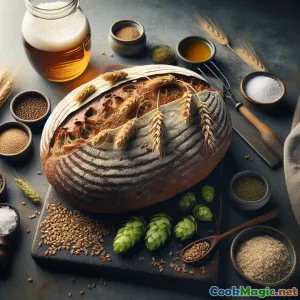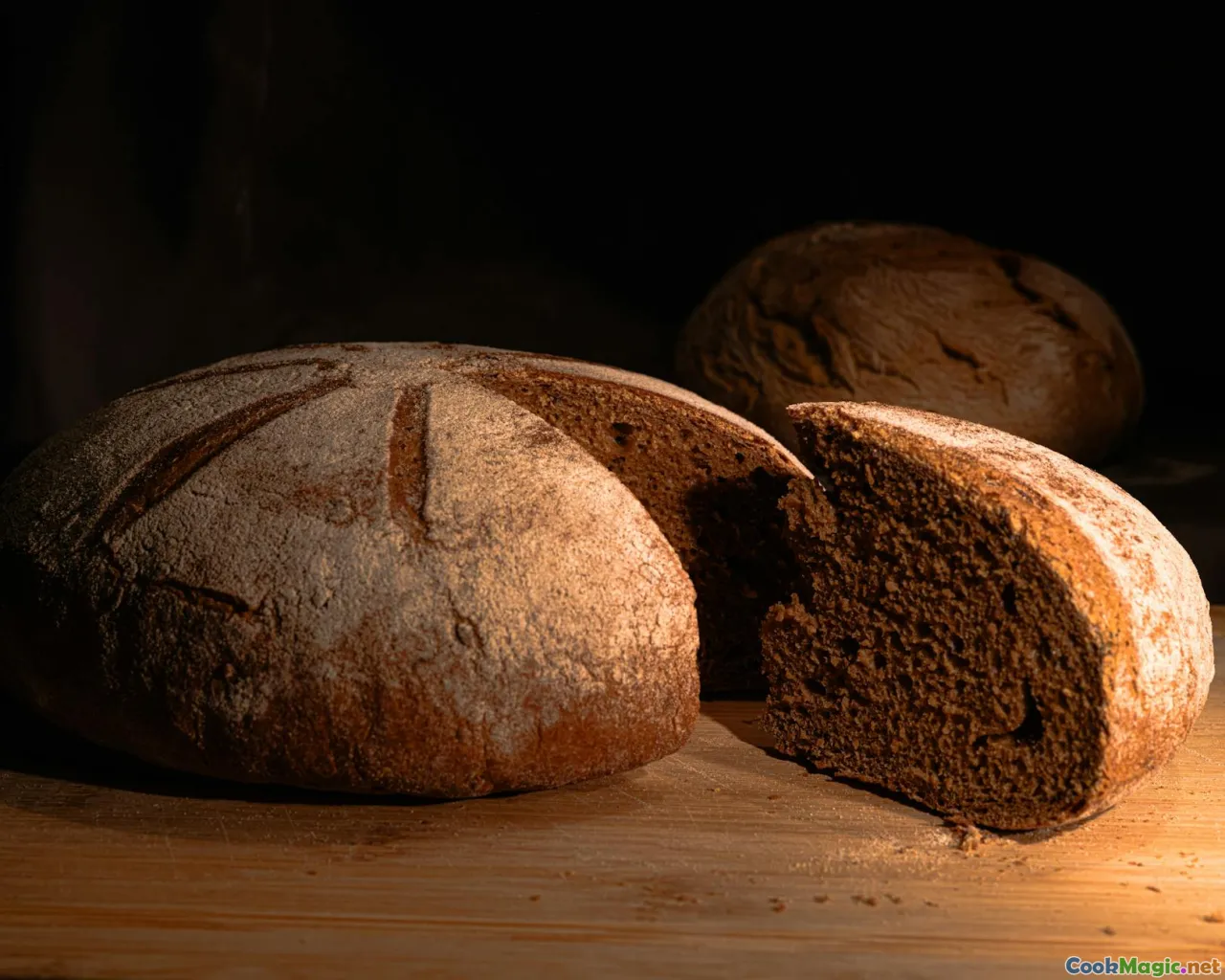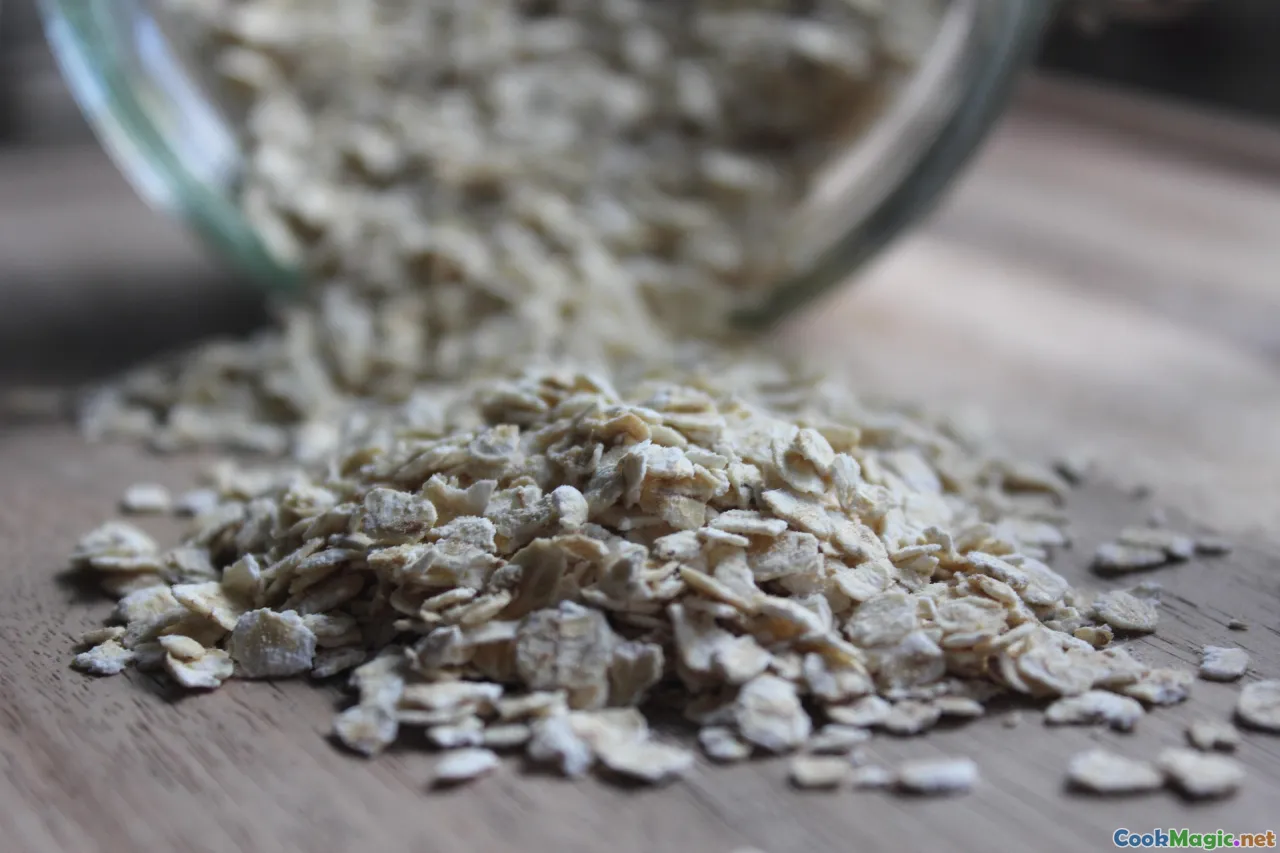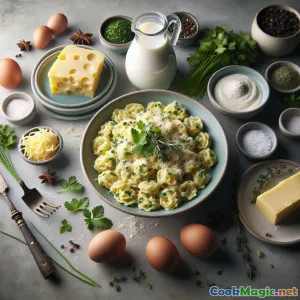
Pain de seigle à croûte de houblon embrassé par la bière
(Beer-Kissed Hopfenkruste Rye Loaf)
(0 Avis)0
373
octobre 28, 2025
Signaler un problème
Ingrédients
-
350 grams Farine de seigle complet
(Stone-ground for deeper flavor and color)
-
250 grams Farine de blé pour pain (gluten élevé)
(Adds strength to the rye; substitute high-gluten flour if needed)
-
150 grams Levain actif au seigle (hydratation 100%)
(Fed within 6–12 hours for best lift)
-
250 ml Lager noir ou altbier
(Room temperature; alcohol bakes off, flavor remains)
-
200 ml Eau
(Adjust 10–20 ml either way to reach tacky dough)
-
4 grams Pellets de houblon ou cônes de houblon séchés
(German noble hops (Hallertau, Tettnang) for floral, gentle bitterness)
-
250 ml Eau bouillante (pour le thé au houblon)
(To steep hops; some goes in dough, the rest for crust)
-
12 grams sel de mer fin
(Balances sweetness, regulates fermentation)
-
20 grams Mélasse ou sirop sombre de malt d’orge
(Adds malty depth and color)
-
3 grams Levure instantanée
(Optional boost if your starter is mild or timing is tight)
-
3 grams Graines de carvi
(Classic rye pairing)
-
1 grams Coriandre moulu
(Citrusy warmth to lift the rye)
-
5 ml Huile neutre
(For greasing the bowl or hands)
-
15 grams Farine de riz
(Dusting proofing basket; prevents sticking)
-
15 grams Farine de seigle supplémentaire
(For dusting the hop crust before baking)
-
6 pieces Glaçons
(For steam if not baking in a Dutch oven)
(Stone-ground for deeper flavor and color)
(Adds strength to the rye; substitute high-gluten flour if needed)
(Fed within 6–12 hours for best lift)
(Room temperature; alcohol bakes off, flavor remains)
(Adjust 10–20 ml either way to reach tacky dough)
(German noble hops (Hallertau, Tettnang) for floral, gentle bitterness)
(To steep hops; some goes in dough, the rest for crust)
(Balances sweetness, regulates fermentation)
(Adds malty depth and color)
(Optional boost if your starter is mild or timing is tight)
(Classic rye pairing)
(Citrusy warmth to lift the rye)
(For greasing the bowl or hands)
(Dusting proofing basket; prevents sticking)
(For dusting the hop crust before baking)
(For steam if not baking in a Dutch oven)
Nutrition
- Portions: 12
- Taille de portion: 1 tranche (80g)
- Calories: 220 kcal
- Carbohydrates: 0 g
- Protein: 6 g
- Fat: 2 g
- Fiber: 6 g
- Sugar: 3 g
- Sodium: 360 mg
- Cholesterol: 0 mg
- Calcium: 40 mg
- Iron: 2.3 mg
Instructions
-
1 - Brew hop tea:
Pour 250 ml boiling water over 4 g hops. Steep 8–10 minutes, then strain. Cool to room temperature. Reserve 30 ml for the dough and keep the remainder for brushing the crust.
-
2 - Autolyse the flours:
In a large bowl, mix 350 g rye flour and 250 g bread flour with 250 ml beer and 170–180 ml water until no dry spots remain. Cover and rest 30 minutes to hydrate.
-
3 - Mix the dough:
Add 150 g active rye starter, 12 g salt, 20 g molasses (if using), spices (caraway and coriander), optional 3 g instant yeast, and 30 ml cooled hop tea. Mix until cohesive and tacky.
-
4 - Develop structure:
With wet hands, perform 3–4 rounds of stretch-and-folds at 5-minute intervals. Rye weakens gluten; gentle folds help alignment without overworking.
-
5 - Bulk ferment:
Lightly oil a bowl. Ferment 2–3 hours at 24–26°C until 60–75% risen with a domed top. Perform one or two coil folds in the first hour if the dough spreads.
-
6 - Prepare basket:
Dust a banneton or towel-lined bowl generously with rice flour to prevent sticking. Keep additional rye flour nearby for finishing.
-
7 - Preheat Oven:
Place a Dutch oven (or a baking stone and steam tray) inside and preheat to 250°C. Heat at least 45 minutes for thorough thermal mass.
-
8 - Shape the Loaf:
Scrape dough onto a lightly damp surface. Pat into a rectangle, letter-fold, then roll into a tight boule or batard. Place seam-side up in the floured basket.
-
9 - Final Proof:
Proof 45–75 minutes at room temperature until the dough slowly springs back when gently pressed. Alternatively, refrigerate 8–14 hours for deeper flavor.
-
10 - Apply hop crust and score:
Invert loaf onto parchment. Brush the surface with reserved hop tea and dust with rye flour. Score decisively with a lame to control expansion.
-
11 - Bake with steam:
Lower to 240°C. Bake 20 minutes covered (or with steam), then uncover and bake 20–25 minutes at 220°C until deep brown. Internal temp ~96°C (205°F).
-
12 - Cool completely:
Cool on a rack at least 2 hours to set the rye crumb. Slice with a serrated knife. Flavor improves by the next day.
Pour 250 ml boiling water over 4 g hops. Steep 8–10 minutes, then strain. Cool to room temperature. Reserve 30 ml for the dough and keep the remainder for brushing the crust.
In a large bowl, mix 350 g rye flour and 250 g bread flour with 250 ml beer and 170–180 ml water until no dry spots remain. Cover and rest 30 minutes to hydrate.
Add 150 g active rye starter, 12 g salt, 20 g molasses (if using), spices (caraway and coriander), optional 3 g instant yeast, and 30 ml cooled hop tea. Mix until cohesive and tacky.
With wet hands, perform 3–4 rounds of stretch-and-folds at 5-minute intervals. Rye weakens gluten; gentle folds help alignment without overworking.
Lightly oil a bowl. Ferment 2–3 hours at 24–26°C until 60–75% risen with a domed top. Perform one or two coil folds in the first hour if the dough spreads.
Dust a banneton or towel-lined bowl generously with rice flour to prevent sticking. Keep additional rye flour nearby for finishing.
Place a Dutch oven (or a baking stone and steam tray) inside and preheat to 250°C. Heat at least 45 minutes for thorough thermal mass.
Scrape dough onto a lightly damp surface. Pat into a rectangle, letter-fold, then roll into a tight boule or batard. Place seam-side up in the floured basket.
Proof 45–75 minutes at room temperature until the dough slowly springs back when gently pressed. Alternatively, refrigerate 8–14 hours for deeper flavor.
Invert loaf onto parchment. Brush the surface with reserved hop tea and dust with rye flour. Score decisively with a lame to control expansion.
Lower to 240°C. Bake 20 minutes covered (or with steam), then uncover and bake 20–25 minutes at 220°C until deep brown. Internal temp ~96°C (205°F).
Cool on a rack at least 2 hours to set the rye crumb. Slice with a serrated knife. Flavor improves by the next day.
En savoir plus sur: Pain de seigle à croûte de houblon embrassé par la bière
What makes this loaf special
Hopfenkruste translates to “hop crust,” a nod to the fragrant hop tea brushed over the loaf just before baking. Rather than tasting like beer, this bread offers a subtle alpine bitterness and floral aroma reminiscent of a Bavarian biergarten, paired with the earthy, cocoa-like depth of rye. The result is a loaf that is rustic yet refined: a shattering, crackly crust; a moist, slightly dense but tender crumb; and a malty, gently spiced profile that begs for butter, smoked fish, or aged cheese.
Technique overview
This bread marries traditional German baking with modern artisan methods. A blend of rye and wheat brings both flavor and structure. Sourdough starter does the heavy lifting for fermentation, while a splash of dark beer adds malt notes and a touch of color. The hop tea—steeped from noble hops like Hallertau—does double duty: a small amount goes into the dough, and the rest brushes the exterior to encourage blistering and a beautiful, rustic finish.
Rye demands a delicate hand. Unlike strong wheat doughs, rye contains pentosans that make the dough sticky and fragile if overworked. Brief autolyse, light incorporation, and gentle stretch-and-folds are preferred over aggressive kneading. Long, calm fermentation coaxes flavor without compromising structure.
Tips for success
- Hydration is a guide, not a rule. Rye flour varies widely. Add water in small increments; the dough should be tacky, not soupy.
- Handle with wet hands. Water prevents sticking and protects dough structure better than adding extra flour.
- Use fresh hops. Aged hops can turn cheesy or harsh. Choose noble varieties for balanced bitterness and floral notes.
- Control bitterness. Keep hop steeping under 10 minutes and avoid over-concentrating the tea.
- Create steam. A preheated Dutch oven is the simplest path to great oven spring and a lacquered crust; otherwise, introduce steam with hot water or ice in a preheated tray.
- Let it cure. Rye crumb sets as it cools. Waiting at least 2 hours (or overnight) deepens flavor and improves sliceability.
Substitutions and variations
- Alcohol-free: Replace beer with water plus 1–2 teaspoons malt extract or molasses for malty notes.
- Yeast-only: If skipping sourdough, increase instant yeast to 6 g and shorten bulk and final proof accordingly.
- Spice swaps: Fennel seed or anise can replace caraway/coriander. Toast spices lightly to bloom aromas.
- Seeded crust: After brushing with hop tea, press a mix of sesame, flax, or sunflower seeds onto the surface before baking.
- Wholegrain boost: Replace 50 g of bread flour with extra rye for a darker, heartier profile; expect a tighter crumb.
Serving and pairing
- Serve with cultured butter, mustardy sausages, cured trout, smoked ham, or aged alpine cheeses like Bergkäse.
- For spreads, try quark with herbs, pickled onions, or a sharp mustard-honey butter.
- Drinks: A malty dunkelweizen, smoky rauchbier, crisp pilsner, or a strong black tea pairs beautifully with the bread’s hop-kissed aroma.
Storage and make-ahead
- Store whole, uncut loaves at room temperature in a paper bag or bread box for 2–3 days. Avoid plastic; it softens the crust. Re-crisp at 220°C for 8–10 minutes.
- Freeze sliced loaf well-wrapped for up to 2 months. Toast from frozen.
- The flavor deepens on day two—an ideal make-ahead for weekend brunch.
Troubleshooting
- Dense or squat loaf: Underproofing, cool dough, or a weak starter. Extend bulk fermentation or warm the dough slightly. Ensure your starter is active and bubbly.
- Gummy crumb: Sliced too soon. Let cool fully. Check final baking—aim for 96°C internal.
- Pale crust: Insufficient steam or oven heat. Preheat longer; brush more hop tea; avoid over-flouring the surface.
- Bitter finish: Over-steeped hops. Keep the tea under 10 minutes and use noble varieties.
Cultural notes
Germany’s love affair with hops is legendary, guided by the Reinheitsgebot (Beer Purity Law) and centuries of hop-growing regions like Hallertau. Bakers borrowed the brewer’s pantry—malt, spent grain, and hops—to extend flavor in everyday loaves. Hopfenkruste embodies this cross-pollination: a baker’s bread that nods to the brewhouse, aromatic yet restrained, and perfect for the robust, savory foods of Central Europe.
Why you’ll remember it
The first slice releases a whisper of hops—herbal, meadowy, never aggressive—setting the stage for rye’s dark sweetness, the slight tang of sourdough, and a crackling crust that sings as it cools. It’s a loaf with character and comfort, the kind that anchors a meal or turns simple butter into a course of its own. Once you’ve tasted the hop-kissed crust, you may find yourself brushing hop tea on many future bakes.























